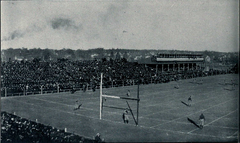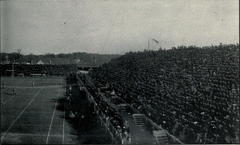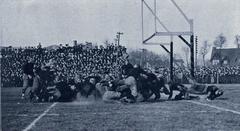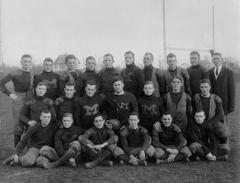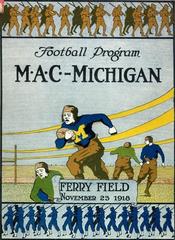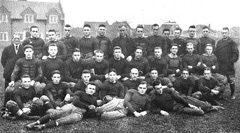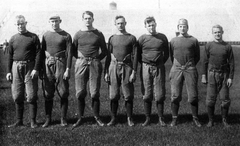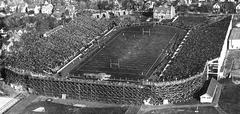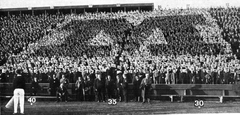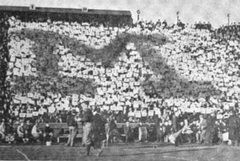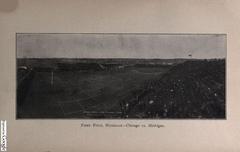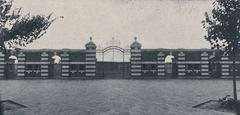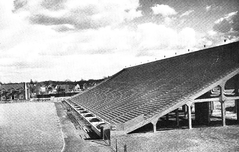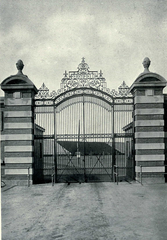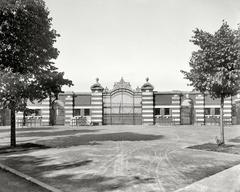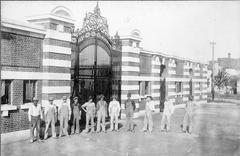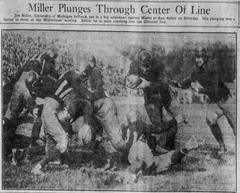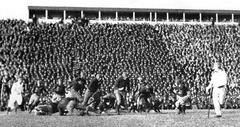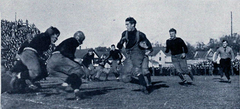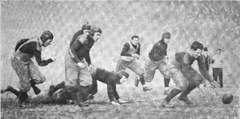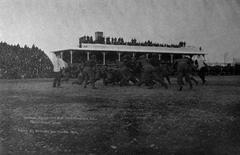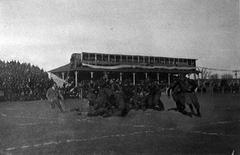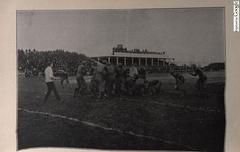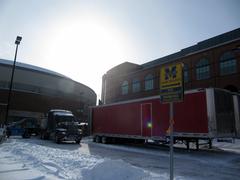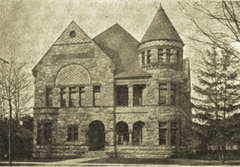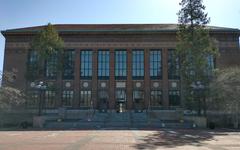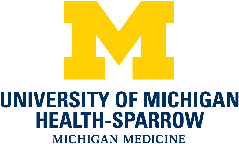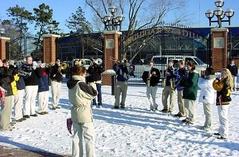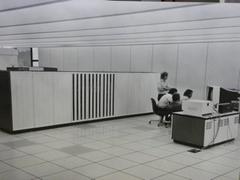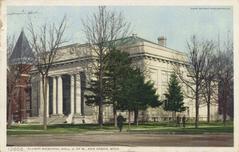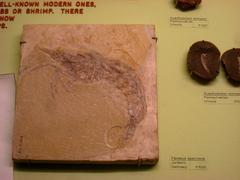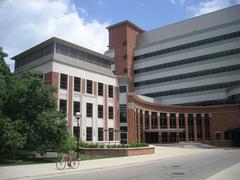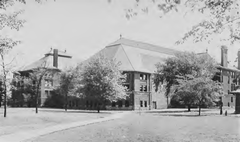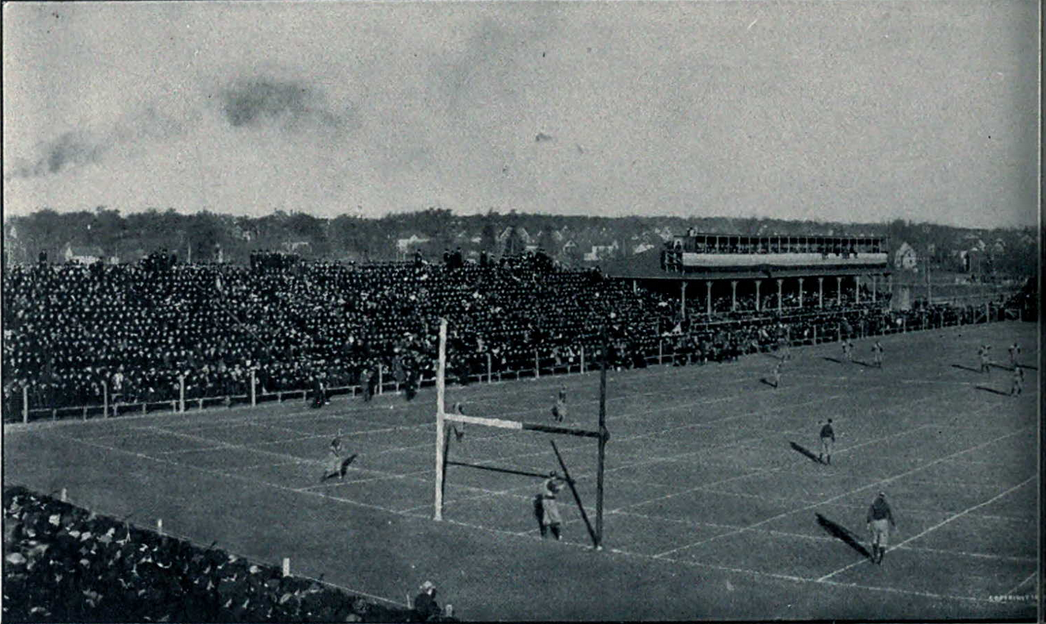
Ferry Field Ann Arbor Visiting Hours, Tickets, and Historical Sites Guide
Date: 14/06/2025
Introduction
Ferry Field, situated just north of the University of Michigan campus in Ann Arbor, is a landmark of enduring athletic and cultural significance. Established in the early 20th century through the philanthropy of Dexter M. Ferry, this historic field is best known as the former home of Michigan Wolverines football and the site of Jesse Owens’ legendary 1935 track performance. Today, Ferry Field remains a vibrant community hub, hosting track and field events, local running groups, and spirited tailgating on football game days. Whether you are a sports devotee, a history aficionado, or a traveler seeking authentic Ann Arbor experiences, this guide details everything you need to know about visiting Ferry Field—including hours, ticketing, accessibility, nearby attractions, and travel tips.
(University of Michigan Athletics, MLive, Ann Arbor Track Club)
Contents
- Visitor Information: Hours, Tickets, and Access
- Historical Overview
- What to See and Do
- Events, Community Engagement, and Tailgating
- Accessibility and Travel Tips
- Nearby Attractions
- Dining and Accommodation
- Frequently Asked Questions (FAQ)
- References and External Links
Visitor Information: Hours, Tickets, and Access
- Hours: Open daily from dawn to dusk for general public use. Special events or maintenance may affect access; check the University of Michigan Athletics website for updates.
- Admission: No fee or ticket required for general visits. Tailgating and some special events may require advance reservation or a purchased package.
- Access: Ferry Field is wheelchair accessible, with paved pathways and ramps at the historic Albert Kahn-designed gates. For additional accessibility needs, contact the University’s accessibility services.
- Parking: Limited on-site parking is available. During events, use nearby university lots, public transit, or downtown parking. Parking details can be found here.
- Guided Tours: Offered occasionally, especially during university events. Self-guided tours with historical signage are always available.
Historical Overview
Origins and Early Years (1902–1926)
Ferry Field was developed from a 20-acre land donation by Dexter M. Ferry in 1902 to accommodate the University’s expanding athletic needs. By 1906, it featured a brick wall, ornate entrance gates designed by Albert Kahn Architects, and seating for 18,000, later expanded to 25,000+ for football games. Under coach Fielding H. Yost, the “Point-a-Minute” teams established Michigan football’s national reputation here.
Transition and Track & Field Era (Post-1926)
After Michigan Stadium opened in 1927, Ferry Field became the primary venue for track and field. The field’s cinder track hosted university, high school, and community events, and served as a training ground for Olympians and local athletes.
Jesse Owens’ Day of Glory (1935)
On May 25, 1935, Jesse Owens set four world records in under an hour at the Big Ten Track and Field Championships—a feat considered one of the greatest in sports history. A commemorative plaque near the entrance honors this achievement.
Preservation and Modern Use
Today, Ferry Field remains a preserved historic site, with its gates and running track intact. The field is used for university and community events, premium tailgating, and as a gathering point for Ann Arbor’s running community.
What to See and Do
Explore Historic Features
- Albert Kahn Gates: The original brick and ironwork entrance is a photographic highlight and architectural landmark.
- Jesse Owens Plaque: Located at the southeast corner, commemorating the 1935 world records.
- Track and Field Facilities: The track remains open for public use when not reserved for university events.
Walk and Run
Ferry Field is a favorite spot for recreational runners and walkers. Local clubs like the Ann Arbor Track Club host weekly workouts, welcoming visitors of all skill levels (Ann Arbor Track Club).
Self-Guided Tours
Wayfinding and historical signs offer context about the field’s legacy. Enhance your tour by visiting adjacent athletic landmarks, including Michigan Stadium (“The Big House”), Yost Ice Arena, and the Intramural Sports Building.
Community Events
Check the university’s athletics calendar for public track meets, races, or special commemorations. The field’s open layout also makes it ideal for photography and quiet reflection on non-event days.
Events, Community Engagement, and Tailgating
- Tailgating: Ferry Field is a premier location for pre-game festivities during Michigan football home games. The University partners with providers like Tailgate Guys for turnkey packages. Alcohol and grills are allowed in designated areas—review posted policies before attending.
- Community Runs: Ann Arbor Track Club and other groups host open interval workouts, particularly on Tuesday evenings.
- Cultural Events: Its central location allows easy access to Ann Arbor’s summer festivals, art fairs, and performances.
Accessibility and Travel Tips
- Wheelchair Access: Paved pathways and ramps at all main entrances.
- Accessible Parking: Available in nearby lots; check university maps for locations.
- Public Transit: AAATA (TheRide) offers frequent bus service to campus. The FootballRide shuttle operates on game days.
- Best Times to Visit: Spring and fall offer pleasant temperatures and colorful scenery. Early mornings and late afternoons are ideal for a quieter experience or photography.
- Weather: Michigan weather can be unpredictable—bring layers and rain gear as needed.
Nearby Attractions
- Michigan Stadium: Known as “The Big House,” just a short walk from Ferry Field.
- University of Michigan Museum of Art: Features diverse collections and rotating exhibits.
- Nichols Arboretum: Ideal for nature walks and picnics.
- Downtown Ann Arbor: Renowned for local shops, cafes, and vibrant arts scene.
Dining and Accommodation
- Nearby Restaurants: Campus favorites include Zingerman’s Deli, Pizza House, The Brown Jug, and Pretzel Bell. Coffee lovers can visit RoosRoost.
- Lodging: Downtown hotels and campus-area accommodations are recommended, especially for football weekends—book early for best availability.
Frequently Asked Questions (FAQ)
Q: What are Ferry Field’s visiting hours?
A: Open daily from dawn to dusk, except during reserved events.
Q: Is there an admission fee?
A: No, general use is free. Tailgating and special events may require payment or reservation.
Q: Is Ferry Field wheelchair accessible?
A: Yes; paved paths, ramps, and accessible parking are available.
Q: Can I park near Ferry Field?
A: Limited parking is available; use university lots or downtown parking, especially during events.
Q: Are guided tours available?
A: Occasionally, during special events. Self-guided tours are always possible.
Q: Can I run or walk on the track?
A: Yes, when the field is not reserved for university events or practices.
Q: Are pets allowed?
A: No, pets are not permitted on the athletic campus.
References and External Links
- University of Michigan Athletics – Ferry Field
- University of Michigan Athletics – Stadium History
- Ann Arbor Track Club – Local Runs and Workouts
- Ann Arbor Area Convention & Visitors Bureau
- Ann Arbor Area Transportation Authority
- Ann Arbor Observer – Events Calendar
- Wondrous Drifter – Ann Arbor Attractions
- Make Time to See the World – Ann Arbor Guide
- Maize N Brew – Michigan Football Travel Guide
- University of Michigan – Parking and Transportation
Final Tips and Summary
Ferry Field is a living emblem of Ann Arbor’s athletic tradition and community pride. Free to access, centrally located, and rich in history, it offers a rewarding experience for visitors of all backgrounds. Plan your trip to include nearby attractions, immerse yourself in campus culture, and take advantage of local resources for a memorable visit. For current updates, event details, and personalized travel guides, download the Audiala app and follow Ann Arbor attractions on social media.
Ferry Field invites you to walk in the footsteps of legends, celebrate community, and discover the enduring spirit of Michigan athletics.
(University of Michigan Athletics, MLive, Ann Arbor Track Club)
